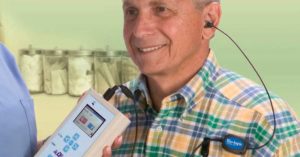Consultation & Testing
As you might suspect, today’s technology has had a positive impact of hearing evaluation. Sharon uses all available technologies to get you on the path to better hearing. This pathway is referred to as an Audiometric Evaluation and consists of a several tests.
Priority One
Interestingly, the first step has nothing to do with technology. She LISTENS. She will prompt you with questions such as family history and overall health concerns. She will want to know when you began to sense hearing loss and if you also suffer from Tinnitus or dizziness. Primarily, however, she will listen. Only you can reveal the concerns you may have regarding your hearing health. Only you can determine if the evaluation should proceed to subsequent steps.
Otoscopic Evaluation
This simple test will check for the buildup of cerumen (or ear wax), the integrity of your ear drum, and any abnormalities of the ear canal that may affect testing or require medical attention. It is an essential step for subsequent procedures.


Pure Tone Conduction Test
A pure tone air conduction test measures the softest, or least audible, sound that a person can hear. During the test, you will wear insert earphones and hear a range of sounds directed to one ear at a time. The loudness of sound is measured in decibels (dB). The tone of sound is measured in frequencies (Hz). The Normal hearing range is from 250-8,000 Hz at 25 dB or lower for adults and 15dB or lower for children. The pure tone test is repeated using a bone conduction device to assess similarities and difference to the air conduction thresholds obtained to assist in the diagnosis.
Word Recognition Test
This test (also called a speech discrimination test) assesses a person’s ability to understand speech. If your speech discrimination is poor, speech may sound garbled. This test is routinely completed in quiet and without visual cues.

However, an additional test in the presence of background noise may also be performed when trying to diagnose your auditory processing abilities. This speech-in-noise test is often used as a tool to determine if directional microphones or other type of assistive device may be needed to optimize your hearing abilities.
Tympanometry Test
A tympanometry test detects problems in the ear such as fluid buildup, perforated eardrum,or ossicular bone damage. Acoustic reflex testing evaluates the automatic response of the brainstem to a sound presented to the ear at various frequencies.

Otoacoustic Emission Test
An otoacoustic emission test (OAE) measures an acoustic response that is produced by the inner ear (cochlea), which in essence bounces back out of the ear in response to a sound stimulus. The test is often used with young patients or those that may be difficult to test since it does not require the patient to participate but only to sit reasonably quiet. If there is an emission present for those sounds presented that are critical to speech comprehension, then that person has “passed” the hearing screen. It is possible to pass this test and still have a problem processing auditory information. So it may be used as part of a test battery.
ABR/BEAR Test
An ABR/BEAR test is another evaluation method that uses a stimulus presented to the ear that detects a neurologic response triggered by the auditory brain stem. This test is often used with infants as part of their evaluation before they leave the hospital and with individuals that are difficult to test. Sharon currently refers this test out when indicated.
Test Conclusion
Sharon will explain your hearing test results on the day of your evaluation and provide a written report for your family physician. If any medical concerns need to be addressed she will provide the appropriate referral. If you demonstrate a sensorineural hearing loss and wish to learn about how a hearing aid might be helpful, then you may proceed with a hearing aid consultation.
From Test to Hearing Management Plan
If your hearing evaluation has indicated that you should treat your hearing loss with hearing aids, then additional information will be taken to determine just how your hearing problem impacts your day-to-day life as well as the lives of your family.
The results from your hearing test will provide Sharon with an outline of what sounds you may be missing or hearing, but the personal answers about your daily life and perception about your hearing provide the basis for a better solution. Things like your vision, dexterity, and any other health concerns like diabetes should be taken into consideration before choosing hearing aid features.

Once you make a decision, Sharon may take impressions of your ears if you selected custom hearing aids or a behind-the-ear hearing aids that require earmolds. Hearing aids must usually be ordered from a manufacturer and then programmed by your audiologist to meet your specific hearing needs. This process can take a few day or a couple weeks, so do not be disappointed when you do not receive your hearing aids the same day as your consultation. All hearing aids are fit with a 30-day, money-back return privilege.
